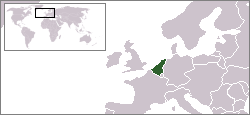Einland

| |
| Flag of Einland | |
| Motto: Unity, Libery, Equality | |

| |
| Region | Africa |
|---|---|
| Capital | Eindhaven |
| Official Language(s) | English (official), Dutch, French, German |
| Leader | President Cheryl DeGrey |
| Population | 26,770,000 |
| Currency | Einish Pon |
| NS Sunset XML | |
History
The history of Einland began with the establishment of an English colony near what is now present-day Eindhaven (Amsterdam), in the 13th century, intending to use it as a springboard for a possible invasion of Denmark. This never materialized, although the city’s strategic location was used to threaten the Danes on several occasions. It was also important in that it furthered England’s control of the channel, and established an English-speaking population on the continent. Eventually, English control spread to cover all the Low Countries, although this control would weaken as England’s hold on France gradually dissolved over the course of the Hundred Years’ War.
Einland remained largely quiescent under English rule, largely due to the success of
the religious balancing act performed by the Tudor monarchs, and no widespread
programs of persecution were pursued against either the protestant majority or the catholic minority (though the latter was viewed with suspicion). However, by the
early 1700’s the Enlightenment swept through Einland with a vengeance. Using the
distraction provided by the American Revolution, in 1776 Einland successfully declared
independence from Britain, with French support, declaring a parliamentary republic
similar to the American model. Unfortunately, this first republic would be short-lived,
as Einland was quickly conquered by Napoleon. Eindhaven fell on November 16,
1795. Following the defeat of Napoleon, Einland would remain incorporated into France, as its liberal ways were viewed as a threat by the Congress of Vienna, and the restoration of its independence was not viewed as an option. Rioting and public sentiment against French rule eventually declined as the liberalization of the regime progressed, culminating with the adoption of the Mulgarian Constitution in 1870.
The Catholic Insurrection
This arrangement was accepted peacefully until 2006, following the outbreak of what would become known as the Catholic Insurrection. Originally Mulgarian territory, Catholic extremists claiming to be led by the self-declared Pope Sixtus XI attempted to take advantage of the deterioration of the Mulgarian government by declaring a catholic theocracy in Belgium and Luxembourg. Following a failed bombing campaign by Mulgaria that left much of these territories in ruins, Papal sovergienty was recognized over Luxembourg, and Mulgarian forces withdrew into france and the Netherlands. They were joined by thousands of refugees as the pope declared the explusion of all non-catholics from catholic-controlled areas. Buoyed by their victory, catholic forces began driving north, taking control of much of the southern netherlands. Rotterdam and the Hague both fell in late may, and without resistance papal forces seemed poised to take Eindhaven itself.
However, fearing for the future of Einland and her people, then-governor Cheryl DeGrey took drastic action. Without declaring independence from the federal government in Mulgaria, the local state government took over many of the functions of a full fledged state. In order to save what was left f the low countries they began to seize control of the fleeing Mulgarian military units and weapons, arm the population, and started organizing resistance against the papal advance. This was accomplished as papist forces were engaged and stopped on a line running roughly from Leiden in the west to Nijmegen in the east. Appeals to the international community were also successful, as weapons and military aid were send by the governments of Cramzpatio and the Danish Commonwealth.
With the advance of its armies halted, the Papal States turned to terrorism. Several protestant churches in Eindhaven were bombed in the early stages of the war. This, combined with the announcement that the campaign of non-catholic expulsion would be extended to the recently conqered southern netherlands led to widespread rioting on both sides of the Einish/Papal line of control. With few police forces and nearly all weaponry being funneled to the war effort, both governments spent most of the war teetering on the brink of internal collapse. And though stymied, the pope's armies were not yet defeated.
The Counter Insurrection and Independence
In early the June the tide began to turn in favor of Einland. Former mulgarian troops and civilian volunteers had been trained and integrated into a more effective fighting force, and the Danish Commonwealth committed troops to the Einish cause and imposed a blockade on the papal-controlled coastline. Thus began the second phase of the Einish Revolution known as the Counter Insurrection. Allied forces began to push south, and scored their first major victory with the liberation of The Hague on June 12, 2006. The einish cause gained further international support following further acts of terror and a failed assassination attempt on Governor DeGrey undertaken by the Papal government. This allowed allied forces to continue the drive south, arriving outside Rotterdam on June 20th. The city fell to Allied control after 4 days of bloody battle.
Following this success the German government, already sympathetic to the Einish cause, made the announcement that would irrevocably turn the tide in Einland's favor: several divisions of the Bundeswehr, including the Heer and Luftwaffe, would be placed in allied control. With most of the southern netherlands liberated, plans were drawn for the final, massive invasion and liberation of Belgium: Operation Missa Solemnis.
